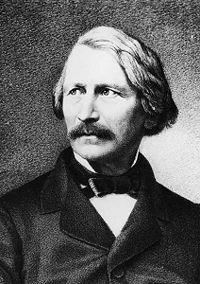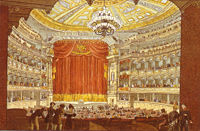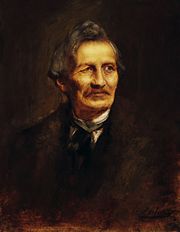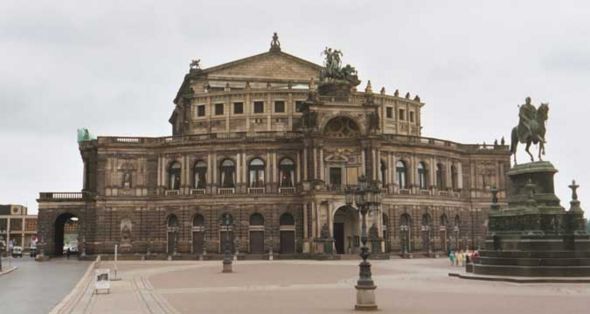Gottfried Semper
| Gottfried Semper | |
 Gottfried Semper |
|
| Personal information | |
|---|---|
| Name | Gottfried Semper |
| Nationality | German |
| Birth date | November 29, 1803 |
| Birth place | Mecklenburg, Germany |
| Date of death | May 15, 1879 (aged 75) |
| Work | |
| Significant buildings | Semper Opera House |
Gottfried Semper (November 29 1803 - May 15 1879) was a German architect, art critic, and professor of architecture, who designed and built the Semper Opera House in Dresden between 1838 and 1841. In 1849 he took part in the May Uprising in Dresden and was put on the government's wanted list. Semper fled first to Zürich and later to London. Later he returned to Germany after the 1862 amnesty granted to the revolutionaries.
Semper wrote extensively about the origins of architecture, especially in his book The Four Elements of Architecture from 1851, and he was one of the major figures in the controversy surrounding the polychrome architectural style of ancient Greece. Semper designed works at all scales, from a baton for Richard Wagner to major urban interventions like the re-design of the Ringstraße in Vienna.
Contents |
Life
Early life (to 1834)
Semper was born into a well-to-do industrialist family in Altona. The fifth of eight children, he attended the Johanneum School in Hamburg before starting his university education at Göttingen in 1823, where he studied history and mathematics. He subsequently studied architecture in 1825 at the University of Munich under Friedrich von Gärtner. In 1826, Semper travelled to Paris in order to work under the architect Franz Christian Gau and he was present when the July Revolution of 1830 broke out. Between 1830 and 1833, he travelled to Italy and Greece in order to study the architecture and designs of antiquity. In 1832, he spent four months involved in archaeological research of the famous Akropolis in Athens.
During this period, he became very interested in the Biedermeier-inspired polychromy debate, which centred around the question whether buildings in Ancient Greece and Rome had been colorfully painted or not. His 1834 publication Vorläufige Bemerkungen über bemalte Architectur und Plastik bei den Alten (Preliminary Remarks on Polychrome Architecture and Sculpture in Antiquity) brought him sudden recognition in architectural and aesthetic circles across Europe[1].
Dresden period (1834 - 1849)

On September 30, 1834 Semper obtained a post as Professor of Architecture at the Königlichen Akademie der bildenden Künste (today called the Hochschule) in Dresden thanks largely to the efforts and support of his former teacher Franz Christian Gau and swore an oath of allegiance to the King (formerly Elector) of Saxony, Anthony Clement. The flourishing growth of Dresden during this period provided the young architect with considerable creative opportunities. In 1838-40 a synagogue was built in Dresden to Semper's design, it was ever afterward called the Semper Synagogue and is noted for its Moorish Revival style.[1] Semper's student, Otto Simonson would construct the magnificent Moorish Revival Leipzig synagogue in 1855.
Certain civic structures remain today, such as the Elbe-facing gallery of the Zwinger Palace complex. His first building for the Dresden Hoftheater burnt down, and the second, today called the Semperoper, was built in 1841. Other buildings also remain indelibly attached to his name, such as the Maternity Hospital, the Synagogue (destroyed during the Third Reich), the Oppenheim Palace, and the Villa Rosa built for the banker Martin Wilhelm Oppenheim. This last construction stands as a prototype of German villa architecture.
On September 1, 1835 Semper married Bertha Thimmig. The marriage ultimately produced six children.
A convinced Republican, Semper took a leading role, along with his friend Richard Wagner, in the May 1849 uprising which swept over the city . He was a member of the Civic Guard (Kommunalgarde) and helped to erect barricades in the streets. When the rebellion collapsed, Semper was considered a leading agitator for democratic change and a ringleader against government authority and he was forced to flee the city.
He was destined never to return to the city that would, ironically, become most associated with his architectural (and political) legacy. The Saxon government maintained a warrant for his arrest until 1863. When the Semper-designed Hoftheater burnt down in 1869, King John, on the urging of the citizenry, commissioned Semper to build a new one. Semper produced the plans, but left the actual construction to his son, Manfred.
Post-revolutionary period (1849 - 1855)
After stays in Zwickau, Hof, Karlsruhe and Strasbourg, Semper eventually ended up back in Paris, like many other disillusioned Republicans from the 1848 Revolutions (such as Heinrich Heine and Ludwig Börne). In the fall of 1850, he travelled to London, England. But while he was able to pick up occasional contracts — including participation in the design of the funeral carriage for the Duke of Wellington — he found no steady employment. If his stay in London was disappointing professionally, however, it proved a fertile period for Semper's theoretical, creative and academic development. He published Die vier Elemente der Baukunst (The Four Elements of Architecture) in 1851 and Wissenschaft, Industrie und Kunst (Science, Industry and Art) in 1852. These works would ultimately provide the groundwork for his most widely regarded publication, Der Stil in den technischen und tektonischen Künsten oder Praktische Ästhetik, which was published in two volumes in 1861 and 1863.[2]
Zürich period (1855 - 1871)
To be completed (German text below)



Die Eidgenossen planten, für die beginnende Industrierevolution ein gesamtschweizerisches Polytechnikum zu errichten. Die eingereichten Wettbewerbentwürfe, die Semper als Experte begutachten sollte, erklärte er alle für ungenügend und zeichnete das neue Hochschulgebäude schließlich selbst. Stolz platziert und von allen Seiten gut sichtbar auf einer Terrasse oberhalb der Zürcher Altstadt, wo kurz vorher noch Befestigungsmauern standen, kam die neue eidgenossische Bildungsanstalt als Zeichen einer neuen Epoche. Das von 1858–1864 errichtete Hauptgebäude, das trotz vielen Umbauten noch heute an Semper erinnert, musste am Anfang nicht nur das neu entstandene Polytechnikum (heute Eidgenössische Technische Hochschule Zürich, ETH), sondern auch die bereits existierende Zürcher Universität aufnehmen.
Semper wirkte ab 1855 als Professor für Architektur am neuen Polytechnikum und viele seiner Schüler sorgten später mit für seinen internationalen Ruhm, nicht ohne Eigennutz, denn die meisten Semperschüler aus Zürich sind selbst berühmte und erfolgreiche Architekten geworden. Ein seiner damaligen Schüler war der Schweizer Architekt Emil Schmid. Die Bezahlung erlaubte es Semper, seine Familie aus Sachsen nach Zürich nachkommen zu lassen.
Zu den weiteren in der Schweiz entstandenen Bauten Sempers zählt unter anderem das Stadthaus in Winterthur.
Für König Ludwig II. von Bayern konzipierte Semper einen Entwurf für ein Richard-Wagner-Theater in München. Die Planung von 1864–1866 für das Festspielhaus blieb unrealisiert.
Later life (from 1871)

To be completed German text
In den 1860er Jahren wurde in Wien die „Museumsfrage“ diskutiert. Die Exponate der kaiserlichen Kunstsammlungen waren in verschiedenen Gebäuden untergebracht. Semper erhielt den Auftrag, einen Vorschlag für Neubauten an der Ringstraße zu machen. Er entwarf 1869 ein riesiges „Kaiserforum“, das jedoch so nicht verwirklicht worden ist. Vor der Wiener Hofburg entstanden als Ergebnis seiner Pläne das Kunsthistorische und das Naturhistorische Hofmuseum und auch das Burgtheater. 1871 siedelte Semper wegen dieser Aufträge nach Wien um. Mit dem ihm zur Seite gestellten Architekten Karl Freiherr von Hasenauer kam es bei den Bautätigkeiten in Wien immer wieder zu Reibereien. 1876 beendete er daher seine Architektentätigkeit an diesem Projekt. Im Folgejahr hatte Semper gesundheitliche Probleme zu bewältigen. Zwei Jahre später starb er auf einer Reise in Italien.

Work (selected)
- Dresden
- Hoftheater – 1838-1841 (destroyed by fire in 1869)
- Villa Rosa – 1839 (destroyed in the Second World War)
- Semper Synagoge – 1839-1840 (destroyed on November 9, 1938 - Kristallnacht)
- Oppenheim-Palace – 1845-1848
- Painting Gallery (Dresden Gemäldegalerie)– 1847-1855
- Neues Hoftheater (Semperoper) – 1871-1878
- Zürich
- City Hall – 1858 (only concept for competition; not built)
- Polytechnical School, (ETH Zurich) – 1858-1864
- Observatory - 1861-1864
- Winterthur
- City Hall – 1865-1869
- Vienna
- Municipal Theater (Burgtheater) – 1873 - 1888
- Museum of Art History (Kunsthistorisches Museum) (1872 – 1881, finished 1889)
- Natural History Museum (Naturhistorisches Museum) (1872 – 1881, finished 1891)
Legacy
Semperdepot, Lehargasse, Vienna
References
- ↑ H.A. Meek, The Synagogue, Phaidon, 1995, p. 188
- ↑ Curl, James Stevens (Paperback). A Dictionary of Architecture and Landscape Architecture (Second Edition ed.). Oxford University Press. pp. 880. ISBN 0-19-860678-8.
- Berry, J. Duncan. The Legacy of Gottfried Semper. Studies in Späthistorismus (Ph. D. Diss., Brown University, 1989).
- Hvattum, Mari. Gottfried Semper and the Problem of Historicism (Cambridge, 2004). ISBN 0521821630
- Herrmann, Wolfgang. Gottfried Semper: In Search of Architecture (Cambridge, MA/London, 1984). ISBN 026208144X
- Karge, Henrik (ed.). Gottfried Semper. Die moderne Renaissance der Künste (Berlin, 2006). ISBN 3422066063
- Mallgrave, Harry Francis. Gottfried Semper - Architect of the Nineteenth Century (New Haven/London, 1996). ISBN 0300066244
- Mallgrave, Harry Francis. Modern Architectural Theory: A Historical Survey, 1673-1968 (Cambridge, 2005). ISBN 0521793068
- Mallgrave, Harry Francis. Architectural Theory: An Anthology from Vitruvius to 1870 (Malden, MA/Oxford, 2006). ISBN 1405102586
- Muecke, Mikesch W. Gottfried Semper in Zurich - An Intersection of Theory and Practice (Ames, IA, 2005). ISBN 978-1-4116-3391-9
- Nerdinger, Winfried and Werner Oechslin (eds.). Gottfried Semper 1803-1879 (Munich/Zurich, 2003). ISBN 3791328859
- Semper, Gottfried. The Four Elements of Architecture and Other Writings. Trans. Harry F. Mallgrave and Wolfgang Herrmann (Cambridge, 1989). ISBN 0521354757
- Semper, Gottfried. Style in the Technical and Tectonic Arts; or, Practical Aesthetics. Trans. Harry F. Mallgrave (Santa Monica, 2004). ISBN 0892365978
See also
- Dresden school
- Neorenaissance
- Historicism
- Architectural theory
- Alfred Friedrich Bluntschli
- Hans Auer
- Constantin Lipsius
- Paul Sédille
- Otto Wagner
- Camillo Sitte
- Hendrik Petrus Berlage
- Bernard Maybeck
- Christopher Dresser
- Alois Riegl
- Richard Wagner
- Gesamtkunstwerk
- Architectural Realism